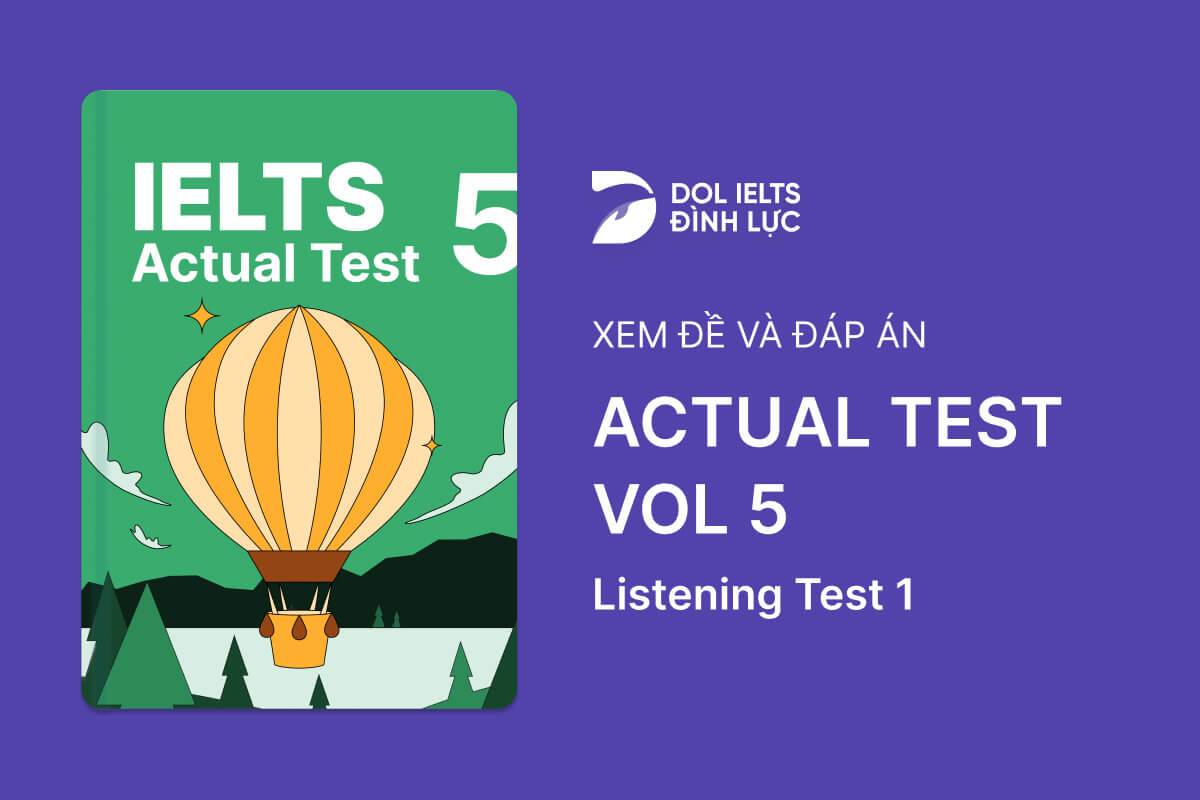Đề thi IELTS Online Test Actual Test 5 - Listening Test 1 - Download PDF Câu hỏi, Transcript và Đáp án
Luyện tập đề IELTS Online Test IELTS Actual Test 5 - Listening Test 1 được lấy từ cuốn sách IELTS Actual Test 5 với trải nghiệm thi IELTS trên máy và giải thích đáp án chi tiết bằng Linearthinking, kèm answer key và list từ vựng IELTS cần học trong bài đọc.
Section
👂️ Bài nghe section 1
Go cycling
Bikes can be hired
Should bring
6
mountain climbing
fire is banned
can go
7can sleep in a
8
go hiking
if lucky, visitors can see
in the forest9can also go on a trip to an old
10
❓ Tapescript section 1
🔥 Đáp án & giải thích section 1
Giải thích chi tiết
 Đáp án cần điền là tên của khách sạn
Đáp án cần điền là tên của khách sạn
=> Biết đáp án sẽ tới khi nghe " and could you please help us reserve a hotel?"
 Người đàn ông nói " There is a hotel in Vancouver named Holiday Chilcotin"
Người đàn ông nói " There is a hotel in Vancouver named Holiday Chilcotin"
Và người đàn ông đánh vần "C-H-I-L-C-O-T-I-N,"
=> Đáp án: Chilcotin 
Section
👂️ Bài nghe section 2
❓ Tapescript section 2
🔥 Đáp án & giải thích section 2
Giải thích chi tiết
 Sau khi nghe "First of all, think of the tents." biết đáp án chuẩn bị vào
Sau khi nghe "First of all, think of the tents." biết đáp án chuẩn bị vào
 Tiếp tục nghe "You know at the beginning, the idea was that I arranged to borrow some tents from the college"
Tiếp tục nghe "You know at the beginning, the idea was that I arranged to borrow some tents from the college"
>>> Ý định ban đầu là organiser sẽ chuẩn bị
 Tuy nhiên nghe tiếp "but it proves that they will be used by the hiking club at the same time, so I'm afraid you will have to bring your own"
Tuy nhiên nghe tiếp "but it proves that they will be used by the hiking club at the same time, so I'm afraid you will have to bring your own"
>>> Họ cũng sử dụng lều nên mọi người phải tự mang
>>> Đáp án đúng là A 
Section
👂️ Bài nghe section 3
❓ Tapescript section 3
🔥 Đáp án & giải thích section 3
Giải thích chi tiết
 Sau khi nghe " What do you figure out so far? "(tìm hiểu được gì -> sắp đưa thông tin về Pacific tapa cloth)
Sau khi nghe " What do you figure out so far? "(tìm hiểu được gì -> sắp đưa thông tin về Pacific tapa cloth)
 Sau đó Helen nói tiếp " Actually, people in other parts of the world have also produced high-quality cloth from bark."
Sau đó Helen nói tiếp " Actually, people in other parts of the world have also produced high-quality cloth from bark."
=> Nơi khác cũng có thể sản xuất high-quality cloth từ vỏ cây
=> Loại đáp án B 
 Sau đó nghe tiếp "But what set pacific tapa apart is the incredible variety role it's played in this region."
Sau đó nghe tiếp "But what set pacific tapa apart is the incredible variety role it's played in this region."
Section
👂️ Bài nghe section 4
❓ Tapescript section 4
🔥 Đáp án & giải thích section 4
Giải thích chi tiết
 Mình cần nghe xem loài 'Banded Hair Freak' ngủ đông trong form nào
Mình cần nghe xem loài 'Banded Hair Freak' ngủ đông trong form nào
=> Biết đáp án sắp tới khi nghe "Various butterfly species have formed different patterns of hibernation"
 Sau đó nghe được "For example, the ‘Banded Hair Freak’ hardly hibernates in its full grown adult form, but as an egg."
Sau đó nghe được "For example, the ‘Banded Hair Freak’ hardly hibernates in its full grown adult form, but as an egg."
=> Nó hiếm khi ngủ đông ở dạng trưởng thành mà ngủ đông ở dạng trứng
=> Đáp án: egg 


